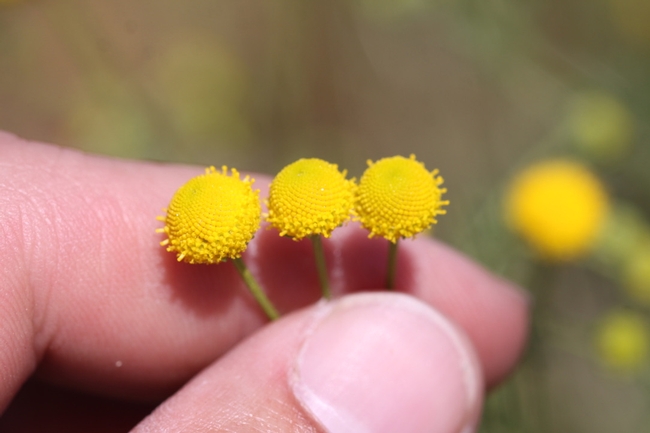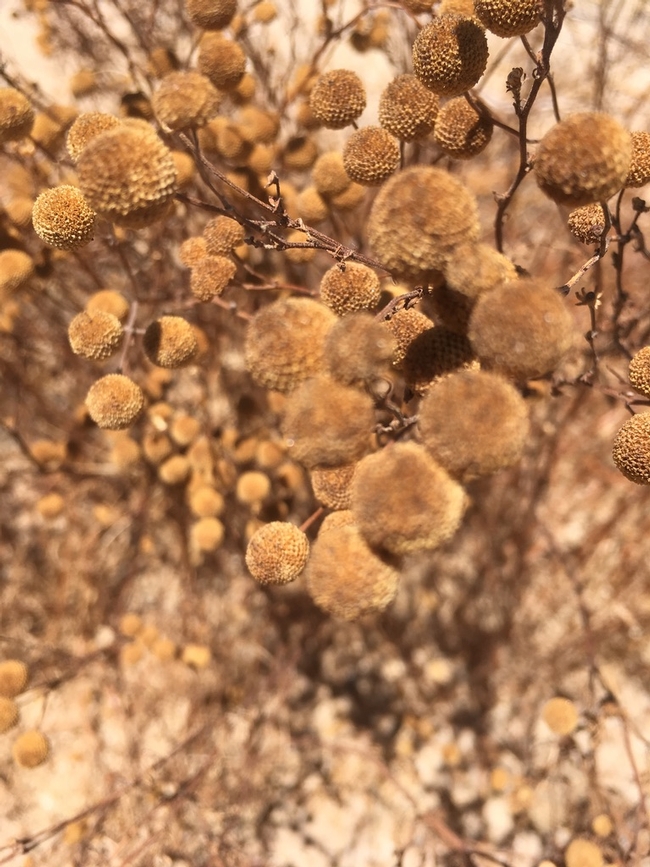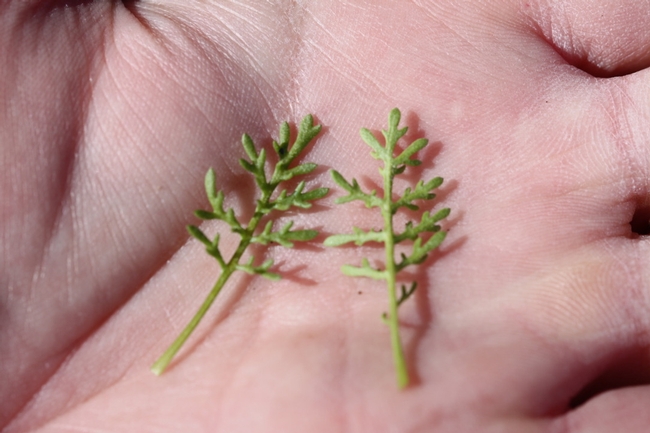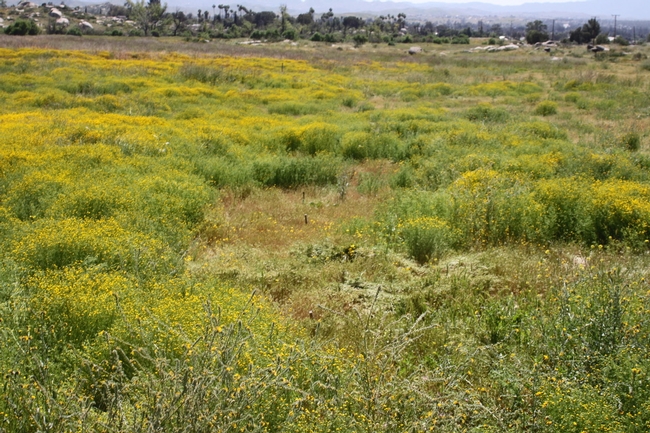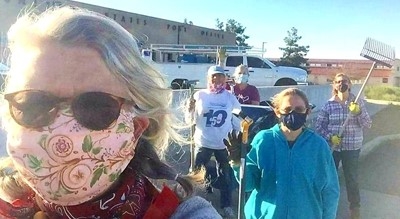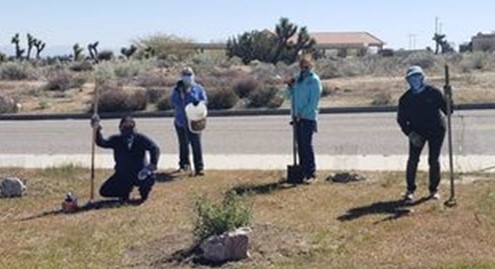o you want to help residents of San Bernardino County garden and landscape more sustainably; grow food in home, school, and community gardens; and improve the health of our communities? Becoming a University of California Cooperative Extension (UCCE) Master Gardener volunteer may just be for you!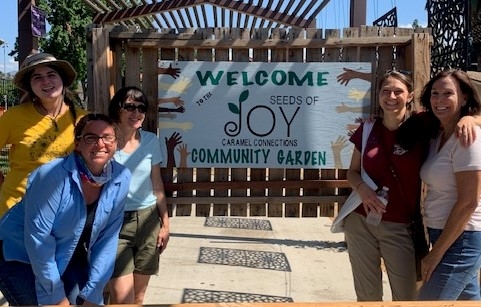
To become a Master Gardener volunteer, you must complete a 50-hour online training course taught by UC and other subject-matter experts.
Important Dates: December 15, 2021: Deadine to complete online application Continuous (through January 7, 2022): Rolling acceptance of applicants on an individual basis.
January 31, 2022: $150 class fee paid online, Master Gardener handbook purchased (not included in tuition: $28-$40), and background check completed (not included in tuition: $25-$40)
April 30, 2021. Final date to complete on-line course requirements (view and complete quizzes for all modules, complete a midterm and final exam, and a class presentation online or in-person.
June 30, 2023: Final date to complete your required 50 volunteer hours. MG program graduation requirements include viewing and completing quizzes on all classes, passing an open book midterm and final exam, and co-presenting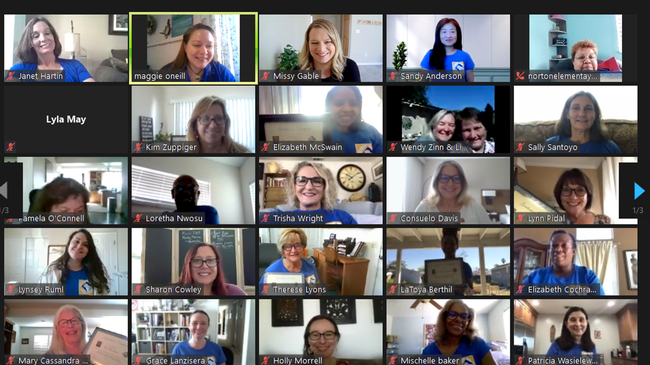
UCCE will ensure the health and safety of accepted applicants and the public served through the program by requiring physical distancing and other precautions as necessitated by COVID-19 throughout the training and volunteer period, including returning to all on-line formats if necessary.
In addition to completing and submitting the online application found here: https://surveys.ucanr.edu/survey.cfm?surveynumber=36040, you must attend (via Zoom) an information/Q and A sessions about the program. Saturday, November 20, 2021 (2-4 PM) Tuesday, November 30, 2021 (7-9 PM) Wednesday, December 1, 2021 (7-9 PM) Saturday, December 4, 2021 (3-5 PM) Saturday, December 11, 2021 (9-11 AM). 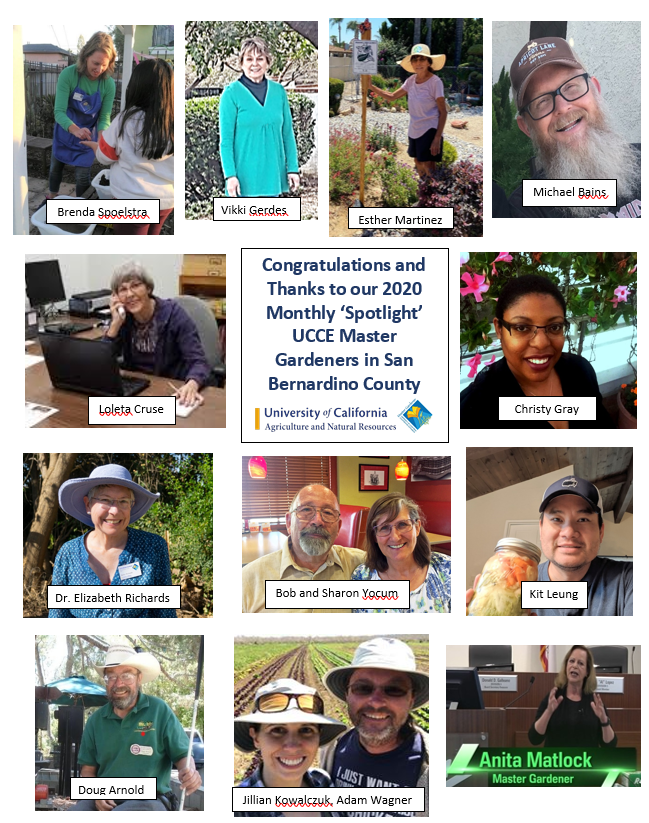
- Author: Chris McDonald
Stinknet (Oncosiphon pilulifer) is a relatively new weed to North America and has been moving quickly and spreading in San Bernardino County. Gardeners may have noticed this unusual yellow-flowered plant growing in their yard this year, even though we are in a significant drought. This is a sign of how invasive this weed can be. It would be very wise to remove this plant from your yard and ensure it does not grow in your community.
Stinknet was first discovered in North America in Riverside County in the early 1980's and began to spread shortly thereafter. In the 1990's, it began to spread much more quickly and within 20 years of its discovery, it was found in multiple locations in Riverside and San Diego Counties as well as in central Arizona. Stinknet is a winter annual germinating with the fall and winter rains, blooming in the spring, and usually dying in the summer. However, stinknet seeds in the soil can germinate multiple times a year creating multiple cohorts and making it that much more difficult to remove.
Identification of stinknet:
There are four characteristics you can use to help identify stinknet. Each one by itself may or may not be helpful, and when combined they will help you correctly identify stinknet.
First, and easiest to identify, is the inflorescence is bright yellow and round, almost globe shaped. The bright flowers dry to a dark brown color and tend to hold on to their seeds for many months after the plants die into the summer.
Second stinknet, like the common name suggests, stinks. It has a strong odor which many people find unpleasant, a strong resin, turpentine, pungent pine-like odor. Similar weeds which have a round inflorescence do not have an unpleasant odor (pineapple weed has a pleasant pineapple-like odor).
Third, the leaves of stinknet are finely divided. They are doubly pinnate (bipinnate), meaning the leaves are divided at least two times into smaller divisions. While many plants have this characteristic, this can be useful if your unknown plant is not flowering, has doubly divided leaves and you can smell it.
Last, stinknet germinates in the fall and winter rains, grows as a small rosette through the winter and then starts to bolt and flower in the late winter through spring. In places that receive irrigation or in moist soils, stinknet can flower even longer from the early spring through the summer.
While size can be helpful for some plants, the size of stinknet can be highly variable. Stinknet growing in poor conditions can grow to be only 6 inches tall with a few flowers. In good condition it grows to be almost 3 feet tall with hundreds of flowers and appears almost shrub like.
Local Infestations:
San Bernardino County so far has very few large stinknet infestations, but many scattered infestations. However, this year I've noticed more and more individuals and patches of stinknet in San Bernardino County, many of which will eventually become large infestations, if left to spread.
There are very large infestations in parts of Riverside (see below) and San Diego Counties and Phoenix where stinknet has been invading the longest. In these areas, stinknet covers entire fields and roadsides, covering dozens to hundreds of acres in large patches. There have been very few places in Southern California where stinknet has not continued to spread when left unchecked.
Stinknet is a generalist and can grow in many different types of habitats including wildlands, gardens, suburban landscapes, disturbed areas such as adjacent to roadsides and parking lots, and on hiking trails. It is spreading in San Bernardino County and should thrive in the desert, inland, and at least to 4,000 ft. in elevation in the mountains, and possibly higher. If you do find this plant, report it in the iNaturalist or CalFlora apps.
Stinknet grows very well in Phoenix where winter rainfall is less than what we receive in the San Bernardino County deserts. Unfortunately, stinknet flowers every year in Southern California, even when we are in serious drought conditions, allowing it to spread farther each year.
Stinknet is one good example of why gardeners should be wary of new plants showing up in their garden. If you didn't plant it, it is likely a weed. Unfortunately, it will take at least 3 years of weeding to remove stinknet from an established site, so keep up the work and you can rid this plant from your garden and neighborhood.
- Author: Debbie LeDoux
UCCE San Bernardino County Master Gardener, Meredith Hergenrader says that one of the best parts of volunteering at Master Gardener events is the camaraderie of gardeners sharing gardening tips and tricks with each other. She has been an active UCCE San Bernardino County Master Gardener volunteer and sharing her gardening knowledge in many Master Gardener events since her graduation in 2016 and resides in the high desert.
Before the cancellation of regularly scheduled monthly events at the Hesperia Library due to COVID restrictions, the San Bernardino County Master Gardeners and UC San Bernardino County Master Food Preservers gave presentations on various gardening topics at the library. Meredith gave presentations on integrated pest management (IPM). With a strong belief in IPM, she does not use chemicals on any of her property. She uses natural and cost-effective ways to get rid of pests. Meredith has also volunteered at local farmers' markets in Wrightwood and Phelan, answering attendees' gardening questions.
One of the most significant things that Meredith learned through being a member of the Master Gardener program is the importance of being water-wise. She says that with water resources becoming increasingly limited, we need to make the best use of the water available with an eye towards future sustainability. The Master Gardener program teaches us ways to do that. One of the methods is by planning our gardens around the needs of plants. Meredith says, “We should use plants that naturally grow in the space they are planted, and by using native plants.”
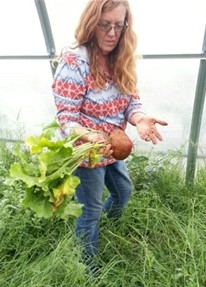
She advises everyone, especially if you consider using graywater in your garden, to be aware of ingredients in detergents and soaps you use. She makes her own cleaning agents like dish soap and clothing detergent. She does not use fabric softeners or products that are scented and don't easily biodegrade. With better technology, fabrics, and laundry products, fabric softeners are no longer necessary. Instead, Meredith occasionally adds vinegar to the rinse cycle as a softener.
Meredith believes that if you see something that needs to be fixed, “be the solution” and do something about it. She and a group of Master Gardeners and other volunteers were motivated to do something after seeing the vegetation at the Phelan Post Office being removed because of the rising cost of upkeep. She approached the postmaster with the idea of using natives and other plants that would not need much water. She received his approval to proceed with the project and quickly started to work.
It was a large space, so Meredith tackled the job in three sections. Meredith and other volunteers provided native and other drought-tolerant plants for the first area. In the second area, she planted succulents and cactus that she dug up from her own property. 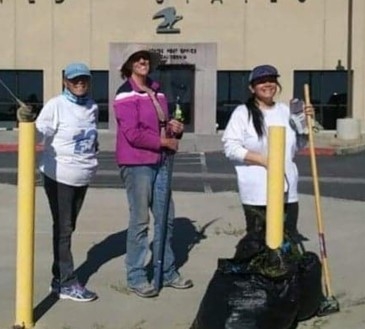
Meredith would like to thank Wendy Walsh Walker for her wonderful donations of a California Flannelbush and Penstemon spectabilis. The California Flannelbush is a fast-growing evergreen shrub that can grow 20 feet high by 20 feet wide and is one of the most spectacular of the native California shrubs. Meredith said: “The team has been fortunate to have Wendy as an advisor for the project. She has studied California native plants and natural history all her adult life. She worked for the Riverside Corona Resource Conservation District, doing habitat restoration for four years before moving to Transition Habitat Conservancy.”
The maintenance worker at the post office was concerned about having to water the plants. Meredith explained that only native and other water-wise plants were used, and once they were established, they would require minimal water. She watered the plants for the first year but has not watered them for the past year, and they are still alive and well.
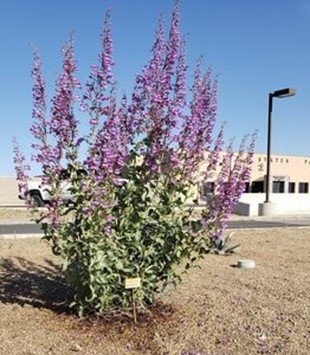
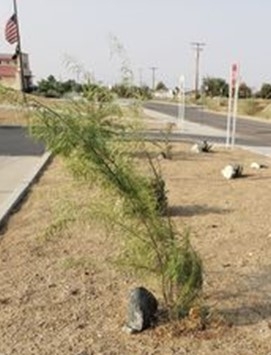
Last summer, the post office grounds had become overgrown with weeds. The maintenance staff did not have time to maintain the grounds. Because of COVID, they were being utilized to clean inside the post office full-time. Funds at the post office were too low to hire more staff.
Around the time the post office was becoming overgrown with weeds, Meredith received a call “out
of the blue” from UCCE Master Gardener trainee Debi Dossey. Debi asked if Meredith had been responsible for replanting at the post office two years ago and if she was interested in being part of a team of volunteers to clean up the post office grounds. Meredith saw the need and immediately said yes.
A team of volunteers worked early on Saturdays, late on Sundays, and in their free time for several months. Most of the work was done with hand tools. However, they used Weed Eaters to finish work around the pine trees. Meredith wants to acknowledge Debi Dossey for spearheading the clean-up effort at the post office, getting approval from the postmaster, and providing encouragement to her and the other volunteers.
All the volunteers were motivated by a spirit of civic duty. Darlene House (another UCCE San Bernardino County Master Gardener), Amanda Plunkett (owner of BeeRooted, an environmental service “dedicated to promoting healthy environments for honeybees and humans through live bee relocation services, education, and products”), Debbie McAfee (Phelan resident), Barbara Hamilton (Hesperia resident), as well as many other volunteers from local high desert areas participated. Congratulations to you all for a job well done supporting your local community
Meredith is a life-long learner with a desire to acquire ongoing knowledge about gardening, IPM, and protecting the environment. She has extended her gardening knowledge by taking classes at Victor Valley College Agriculture and Natural Resource (AGNR) Department. She is currently taking courses for her own self-knowledge (while toying with the idea of possibly getting an advanced degree in Botany in the future.) She has taken an IPM class, is currently taking a class on identifying 100 non-native plants by their Latin names, and in February, will be taking a class on native plants.
Meredith was recently asked by one of her professors at the AGNR Department to start a seed library at the college. She has wanted to create a seed bank in the high desert, so she agreed. Meredith already has some thoughts about how she will organize the seed library utilizing onsite resources and volunteers. There are greenhouses wherethe library can be set up to bring in seeds that can be traded. There is even an onsite lab where the seeds can be cleaned, dried, and stored. She is looking forward to getting started on the seed library as soon as COVID quarantine restrictions are lifted!
Learning about Meredith's extensive knowledge of holistic health and living a fully holistic lifestyle has been eye-opening and inspirational! In her 20's, she adopted an organic lifestyle and has grown everything organically ever since. Early on, she read a book called "Back to Eden" by Jethro Kloss about herbs, how to use herbs, eat well, and avoid toxins. After reading the book, she concluded that there is probably an answer to almost any problem by using plants.
Meredith has a passion for educating people about keeping a pure seed supply and avoiding pesticides. She has never seen any logical reasons for using a lot of chemicals in our day-to-day lives. She has given talks in the high desert, promoting healthy choices, and encouraging people to lead organic lifestyles.
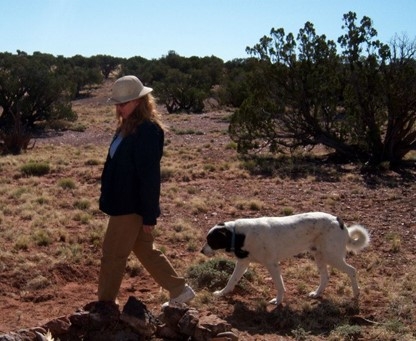
Meredith has an extensive property that includes a goat farm, rabbits, horses, and herb, vegetable, and flower gardens. Over several years, she has removed most of the invasive vegetation on her property while encouraging native plants to take over.
Every year the native plants reseed and have slowly taken over the invasive plants. The native plant areas need little water. However, Meredith installed a drip system to use during the hot summers in the high desert. She enlisted the help of her grandson and granddaughter and their friends to haul way truckloads of weeds. Another generation of farmers in the making!
Meredith's life-long love of farming began on her grandparents' farm in Nebraska. Like many people during that time, they had a farm growing their own vegetables, planting fruit trees, and raising chickens. They canned what they grew and preserved eggs by the water glassing method. Keeping eggs by water glassing is a long-standing historical method that works well for long-term egg storage. Meredith learned to operate farm equipment and helped her grandparents with their farm.
Meredith's fascination with seed saving started with rows of unlabeled jars of seeds on shelves in her grandparents' basement in Nebraska. Her grandmother taught her everything that she knew about farming and seed saving. Meredith learned how to operate farm equipment and plowed areas on the farm. She and her grandmother planted the collected seeds in the cultivated areas. When she was only 10 years old, she produced a large flower garden in Nebraska and won her first garden award (from the Spanish American War Auxiliary that her grandmother was a member of.)
One of the many things I hear Master Gardeners say that they like about being in the group is meeting life-long friends with common interests. It must have been "serendipity" that Meredith met UCCE San Bernardino County Master Gardener Dana Marchica-Herring. She was attending a San Bernardino County Master Gardener composting class presented by Dana in Wrightwood. After the class was over, she and Dana "hit it off," talking about their mutual gardening interests. Dana encouraged Meredith to apply to the Master Gardener program. Dana moved and she and Meredith did not see each other for over 20 years, but Meredith always remembered Dana's encouragement and applied and was accepted into the Master Gardener program years later. After all those years of not seeing each other, Meredith and Dana “ran into each other” giving talks at a Whole Life Celebration in Wrightwood. Dana was representing the San Bernardino County Master Gardeners and Meredith was giving a talk on GMOs. As Meredith likes to say, their friendship came full circle.
Meredith encourages people to think about becoming a Master Gardener by saying, “it is easier than it looks.” Having an interest in gardening and a little gardening experience is a good start. The desire to help others become better gardeners is necessary, but it is also the most fun! She says that becoming a Master Gardener is a commitment, but there are many resources available through the Master Gardener Program that provide ongoing training.
The motto of Meredith's Valhalla Farm is, “A wee small farm with lots of animals, gardens, and penchant for independence.” I think it epitomizes the spirit of Meredith!
The UCCE San Bernardino Master Gardeners thank Meredith for her enthusiasm, diverse gardening knowledge, and dedication to creating a more sustainable future!



